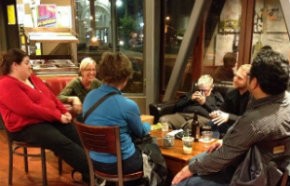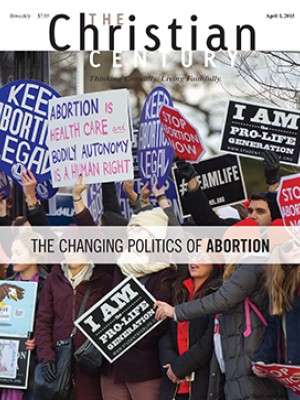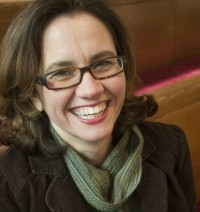Going smaller and deeper

When one looks at a classic painting of an idyllic town, it’s usually not difficult to spot the church. The steeple pierces the sky and soars above the homes and other buildings.
It isn’t just the architecture that has set the church apart. We have attended church on Sunday, offering up the first hours of the week. We have dressed up, making sure that our children are scrubbed and shiny. All of these things have allowed us to bring our best selves before God—our first fruits to that sacred space.
But when Jeff Richards imagines a church in downtown Sacramento, California, he describes a different scene. The church doesn’t tower over the other buildings; instead, it inhabits them. For Richards, church should not be segregated by a certain hour, enfolded by four walls. God should not have a house, where we call upon the divine presence once a week, fulfilling some duty, like visiting an ailing aunt. Instead, church should infuse our whole lives, seeping into every place we breathe and influencing everything we do.
Read our latest issue or browse back issues.
As an evangelist for the Presbytery of Sacramento, Richards started the WordHouse, aiming to dismantle the things that separate church from the rest of our lives. The WordHouse meets in houses, pubs, and coffeehouses. People seek to make worship, fellowship, mission, and discipleship integrated, not segmented, activities.
Worship takes place in a living room or a public space and begins with people checking in with one another. “People are pretty open about their struggles and pain,” Richards said. They may talk about a divorce or a work situation, topics they might have kept quiet about in a traditional church.
Then they look at scripture. Richards invites everyone to discern what the text is saying. People ask questions, trying to understand the history and the characters, and then move to wondering how the text might apply to their lives. “How do we see ourselves in God’s world?” “How are we are part of God’s story?”
Once a month, the WordHouse hosts a potluck, and Richards begins it with an invitation to the table. “The Lord’s Table is celebrated as a literal meal together. Not just a representation through a bite and sip,” Richards explained.
When it comes to fellowship, the community doesn’t hold a coffee hour, where people mingle with disposable cups in a church basement. Instead, they go out together, talk in pubs, drink good coffee, and hang out downtown.
Likewise, their mission takes place with organizations that already exist in the neighborhood. They seek places where God is already at work. Many people involved with the WordHouse work with children who have limited resources. They also go out to the streets and share hot drinks with people who are experiencing homelessness. They have hosted Christmas parties for families who don’t have homes.
Discipleship is a key ingredient of the WordHouse. For Richards, discipleship is “sharing what’s going on in your life, with an element of how it relates to God.” It’s also “socializing and connecting with people and sharing God’s love to see if they want to join you on this journey of knowing that God is with them.”
Beyond this highly relational definition of discipleship, Richards has an expansive vision of a network of disciples: people from the initial group starting other groups, and those groups starting others.
The WordHouse represents a trend away from the “bigger is better” mentality and toward smaller, deeper community. We see this trend when consumers move from patronizing big-box stores to supporting farmer’s markets and microbreweries. People who long for a spiritual life are shifting from the slickly programmed, performance-centered megachurches they grew up in to small, intense, and highly relational communities. As one of thousands at a megachurch, it can be difficult to have much of an opinion about the larger direction of the church. But at the WordHouse, the participants are part of creating each service and the vision of the ministry.
Are these communities sustainable without traditional structures? When I asked Richards if the WordHouse planned to get a building and become a “big church,” he laughed and said that wasn’t a part of the plan. When there are more groups, he could imagine them needing a bigger space so that they could meet together, but that could be done at an existing church. Buildings often outlast their usefulness, and churches sometimes exist to maintain bricks and mortar rather than ministry.
But do the structures provide a sort of permanence that the practice of meeting in homes cannot? These questions will be answered in time. For now, Richards says, “we don’t want to be in a separate building where God lives. There’s an embodiment of the gospel that can be missed if we don’t see our whole life as a place where God is in our midst.”






